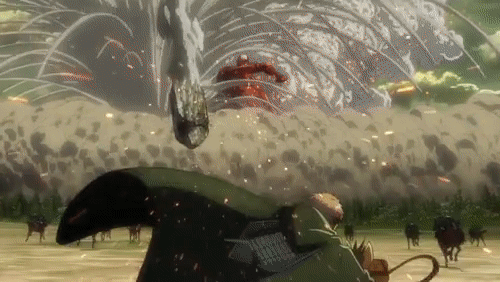Interest
Behind the Action Animation of Kabaneri of the Iron Fortress and Attack on Titan
posted on by Kim Morrissy
Despite forays into emotional dramas lately with The Ancient Magus' Bride and After the Rain, action has always been a heavy part of Wit Studio's brand. The studio was first established in 2012 during the production of Attack on Titan. Most of the core staff came out of Guilty Crown, including the director Tetsuro Araki, who is known primarily for his bombastic action shows. Since then, Wit Studio has continued to thrive on its thrilling action anime, including Kabaneri of the Iron Fortress, Seraph of the End, and the second season of Attack on Titan.
Last month, Wit Studio showed off its major works in an exhibit at the Tokyo Anime Center (which has recently moved from Akihabara to Ichigaya). The exhibit was quite diverse; besides work on various TV anime and films, the studio even showed off its work on the animated segments of the variety show How Do You Like Wednesday? But the biggest showcase was dedicated to Kabaneri of the Iron Fortress, Wit Studio's original IP.




The biggest treat, however, was Wit Studio's character designers and action animators themselves, who personally held a talk show in the Tokyo Anime Center to share their insights on the production process. Yasuyuki Ebara (Kabaneri anime character designer), Kyoji Asano (Attack on Titan anime character designer), Arifumi Imai (Attack on Titan action animation director), and Takuma Ebisu (Attack on Titan season 2 action animation director) were scheduled to have a talk on February 24. Unfortunately, Asano had to pull out because he had the flu, but the others gave an interesting talk in his place.
The animators began by talking about the importance of crafting character designs specifically for animation. Often, an illustrator will provide the original character concept drawings. The chief animation director then redesigns the characters with less linework to make them easier for the animation team to draw.

In the case of Kabaneri, one of the goals of the animation team was to keep as much of the flavor of Haruhiko Mikimoto's original designs as possible. Mikimoto is quite famous for designing the Super Dimension Fortress Macross characters in the 80s and not touching the anime world much since, so capturing his distinct style was important to the team. In fact, Ebara notes that the anime designs are not much easier to animate than Mikimoto's original drawings; Araki even instructed Ebara to include more strings in Mumei's design just because he thought that was cool. The level of detail in the character and costume designs is one of the things that makes Kabaneri stand out among other action anime.
The next important step to creating good action animation is the storyboards, which you can think of as the blueprint of each scene. The action animators all emphasized how closely their animation work hews to the storyboards. Imai joked that Ebara is like a preppy student in this regard. The animators had nothing but praise for Araki's storyboarding skills. In fact, they even talked about occasions when their animation was praised for the cool choreography and they had to respond, “Well, that part was all from the storyboards.”

Tetsuro Araki's storyboards for episode 1 of Kabaneri. (Source: Comic Natalie)
Another thing the animators mentioned is how much they enjoy drawing the “money shots.” Ebisu's concern is making each individual drawing look cool, so the characters are always pulling striking poses in every frame. An inspiration of his is the animator Masami Ōbari, who drew scenes of iconic punching animation that even modern animators continue to reference. Tell me if you haven't seen a scene like this in an anime, where the character pulls their arm back for a pose, tilts their head, and then thrusts their entire body forward:

It is becoming increasingly common in anime today for 2D animators to work with 3D animators to create dynamic action scenes. For example, some scenes in anime will utilize a 3D camera and/or backgrounds. In those cases, the action animators will draw rough key animation to guide the 3D animators.
For example, Ebara drew the rough animation for this sequence in Attack on Titan episode 11. The characters are drawn in 2D but they constantly interact with their 3D environment, so Ebara drew the main objects depicted in the shot as well:

At this point, Ebara cheerfully pointed out the errors in his own animation. “When the characters veer to the side, don't their bodies twist unnaturally?” he said. He mentioned that he was glad that the finished animation covered up his mistakes a little. Animators are constantly searching for ways to improve their work.
Season 2 of Attack on Titan continued to refine the techniques used in the first season, but it also allowed for more freedom from the action animators because Araki encouraged more variation. Imai showed off his own cut from the opening sequence of season 2:

A lot of minor character details are packed into this very short clip, which you can appreciate when you look at it frame by frame.
Finally, the animators took questions from the audience. They even answered a question I asked: How did they get interested in doing action animation in the first place? They all had similar stories to share. They always found action animation cool and appealing, and as they drew the things they liked, their work became noticed by their superiors. Imai notes that there's a certain kind of gratification in seeing the pictures you draw move instantly. He started off his career doing designs and thinks that doing action animation is a nice change of pace.
The Wit Studio exhibit at the Tokyo Anime Center ran from February 9-26. For more information about Wit Studio, check out this interview with studio president George Wada.